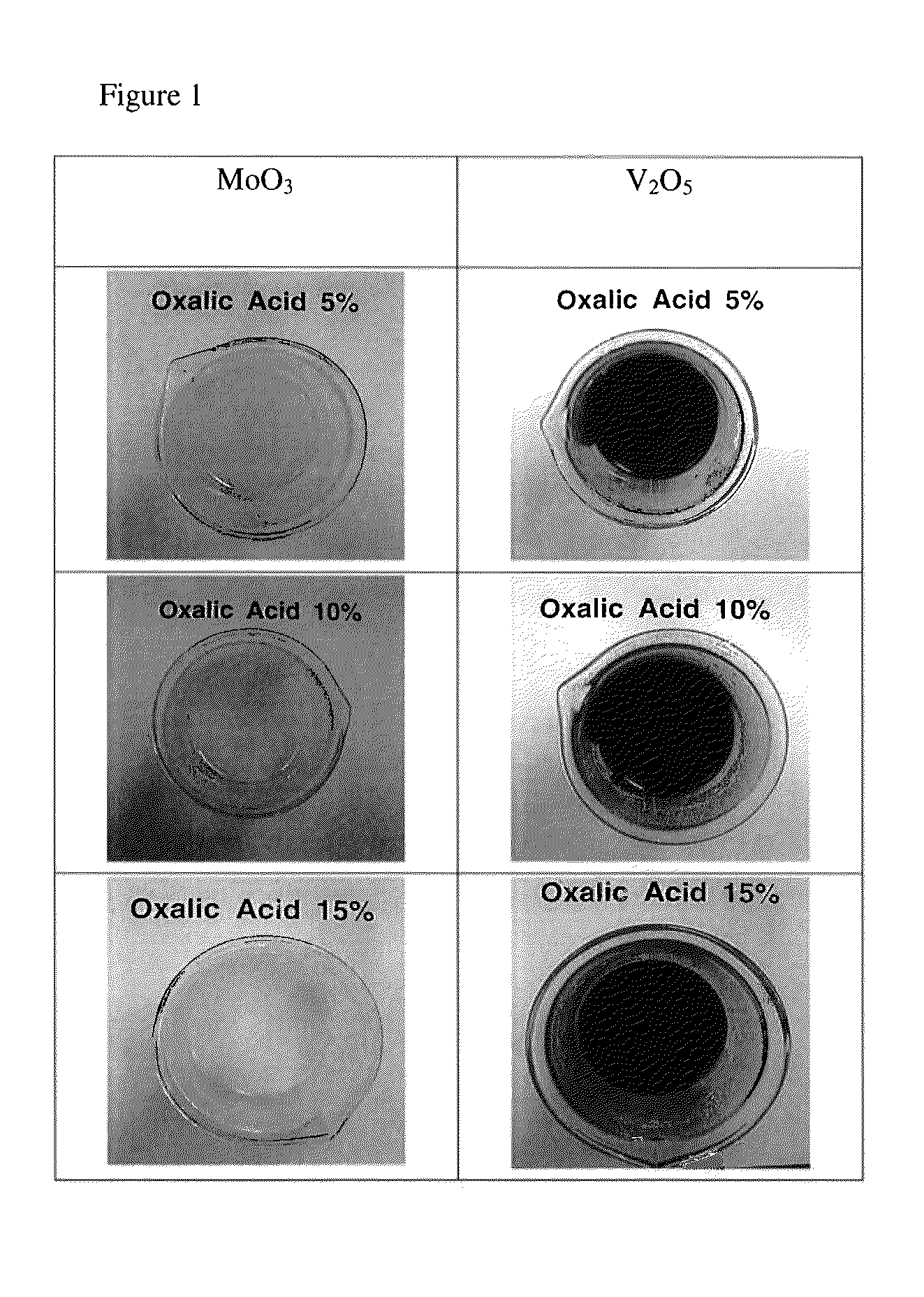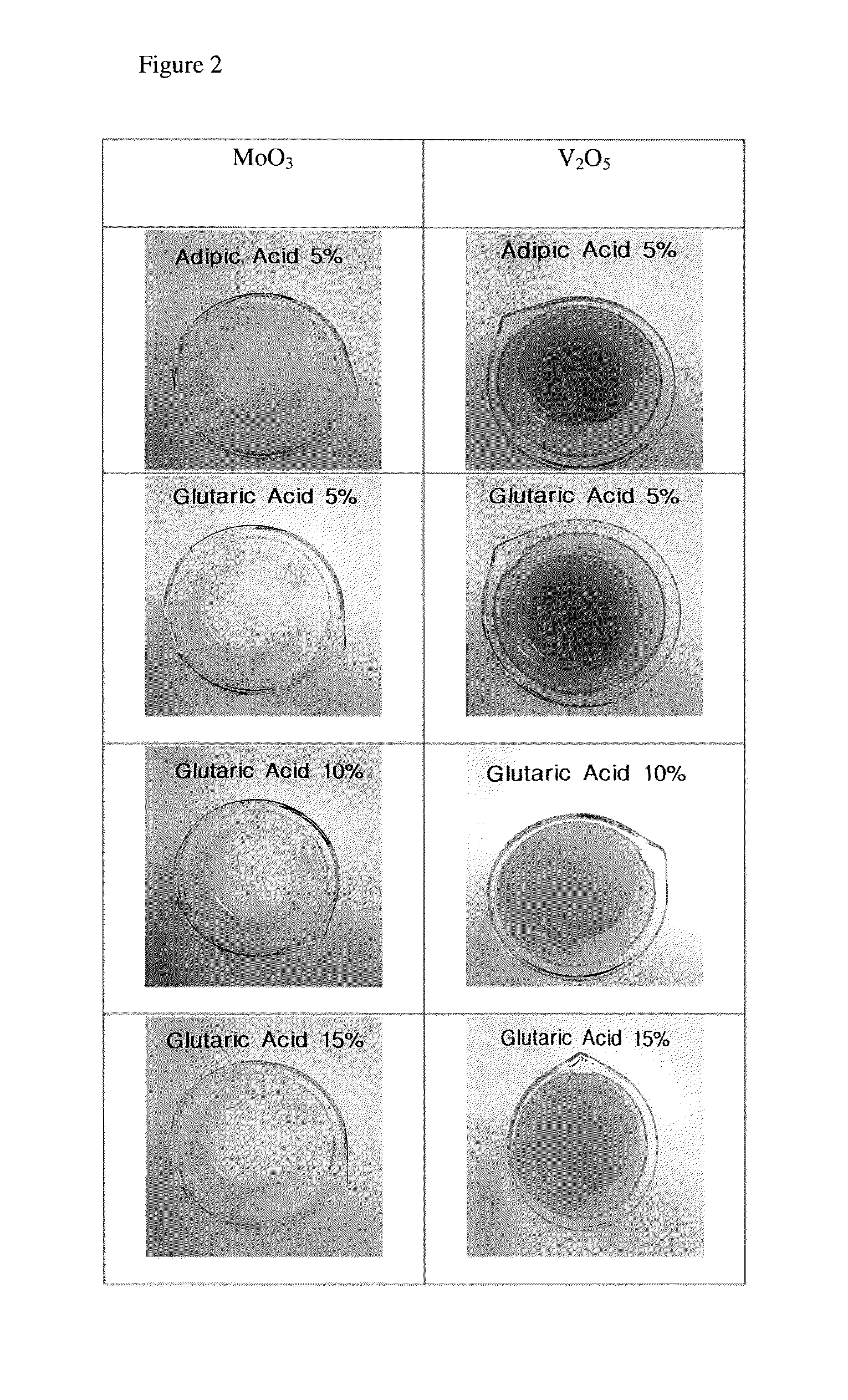Regeneration or remanufacturing catalyst for hydrogenation processing heavy oil, and method for manufacturing same
a technology of hydrogenation processing and catalyst, which is applied in the direction of catalyst regeneration/reactivation, metal/metal-oxide/metal-hydroxide catalyst, etc., can solve the problem of not being able to selectively remove the vanadium present in the spent catalyst, and achieve excellent economic feasibility and reduce environmental burdens
- Summary
- Abstract
- Description
- Claims
- Application Information
AI Technical Summary
Benefits of technology
Problems solved by technology
Method used
Image
Examples
example 1
Experiment of Acid Treatment of Spent Catalyst Using Oxalic Acid Solution
[0062]To examine a leaching reaction between a main active component of the spent catalyst, such as molybdenum, and a main active-degrading component thereof, such as vanadium, and the oxalic acid solution, oxalic acid was dissolved in distilled water in a beaker to prepare an oxalic acid solution with a concentration of 5 to 15%, to which 3 g each of MoO3 and V2O5 was added, and cleaned in an ultrasonic constant temperature container at 45° C. at an ultrasonic intensity of 40 kHz for 15 minutes. The result is shown in FIG. 1. As shown in FIG. 1, the solution containing MoO3 in the beaker was turbid because MoO3 was not completely dissolved, and thus precipitation of white powder on the bottom of the beaker was observed. The solution containing V2O5 in the beaker was dissolved in oxalic acid with green bubbles, and eventually turned dark blue. As the concentration of the oxalic acid was increased, a time taken ...
example 2
Regeneration and Remanufacture of CoMo / γ-Al2O3
[0065]A spent catalyst sufficiently covered with heavy oil was cleaned with a sufficient amount of organic solvent (n-heptane or n-hexane), followed by drying the spent catalyst in a drying furnace at 100 to 120° C. through natural drying.
[0066]Afterward, sintering was performed for 1 to 3 hours by adding a catalyst to a reaction sintering pipe containing 40% of vapor and maintained at 550° C. Here, an aspirator was installed at an outlet region of the sintering pipe to exhaust air aspirated from the sintering pipe, so that sintering in which an activation point of the catalyst was agglomerated did not occur, the carbon contained in the catalyst met the oxygen in the air, thereby completely removing carbon precipitated in the catalyst. Here, the black spent catalyst looked yellowish or yellow showing that the precipitated carbon was completely removed and a catalyst activity-degrading component, vanadium, was precipitated on a surface o...
example 3
Regeneration and Remanufacture of NiMo / γ-Al2O3
[0082]A spent catalyst sufficiently covered with heavy oil was cleaned with a sufficient amount of organic solvent (n-heptane or n-hexane), followed by drying the spent catalyst in a drying furnace at 100 to 120° C. through natural drying.
[0083]Afterward, sintering was performed for 1 to 3 hours by adding a catalyst to a reaction sintering pipe containing 40% of vapor and maintained at 550° C. Here, an aspirator was installed at an outlet region of the sintering pipe to exhaust air aspirated from the sintering pipe, so that sintering in which an activation point of the catalyst was agglomerated did not occur, and the carbon contained in the catalyst met the oxygen in the air, thereby completely removing carbon precipitated in the catalyst. Here, the black spent catalyst looked yellowish or yellow showing that the precipitated carbon was completely removed and a catalyst activity-degrading component, vanadium, was precipitated on a surfa...
PUM
| Property | Measurement | Unit |
|---|---|---|
| BET specific surface area | aaaaa | aaaaa |
| BET specific surface area | aaaaa | aaaaa |
| BET specific surface area | aaaaa | aaaaa |
Abstract
Description
Claims
Application Information
 Login to View More
Login to View More - R&D
- Intellectual Property
- Life Sciences
- Materials
- Tech Scout
- Unparalleled Data Quality
- Higher Quality Content
- 60% Fewer Hallucinations
Browse by: Latest US Patents, China's latest patents, Technical Efficacy Thesaurus, Application Domain, Technology Topic, Popular Technical Reports.
© 2025 PatSnap. All rights reserved.Legal|Privacy policy|Modern Slavery Act Transparency Statement|Sitemap|About US| Contact US: help@patsnap.com



